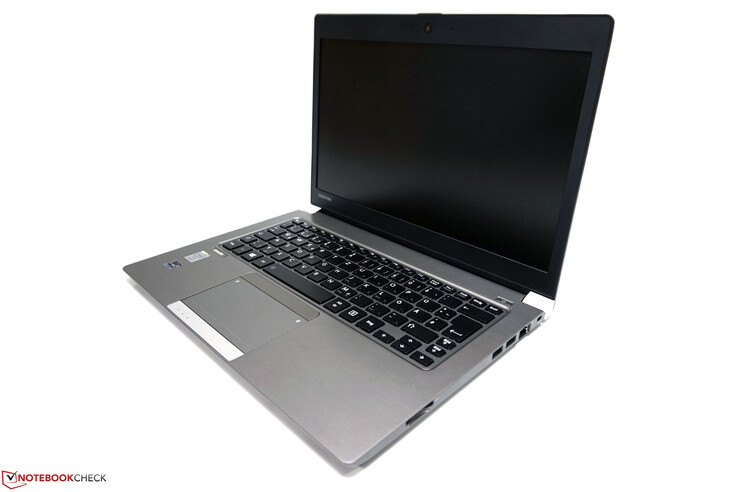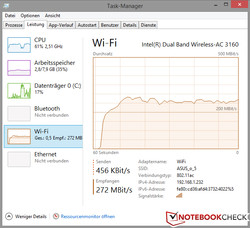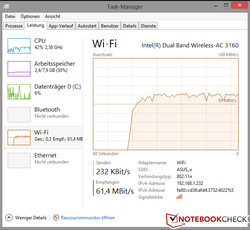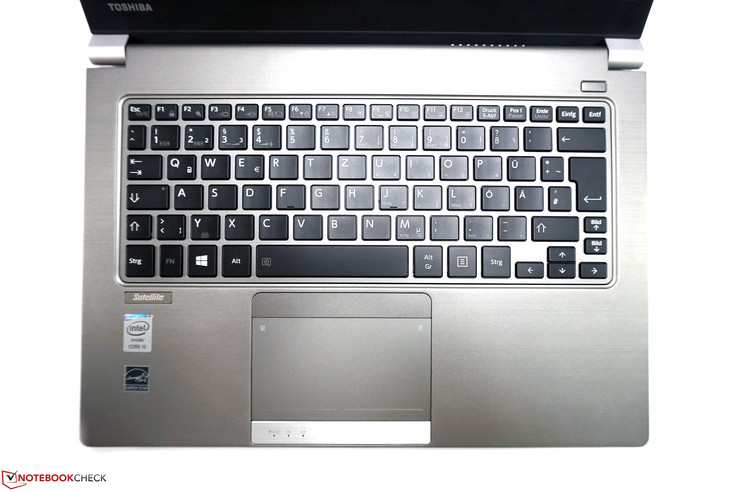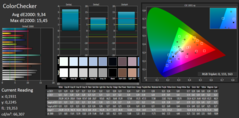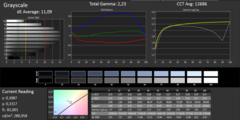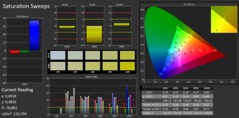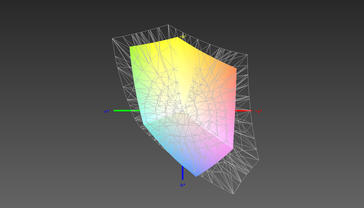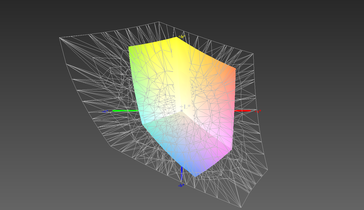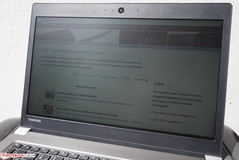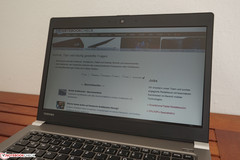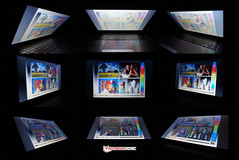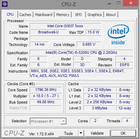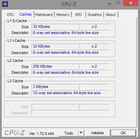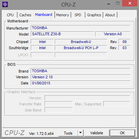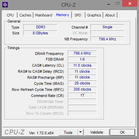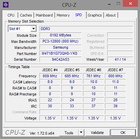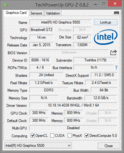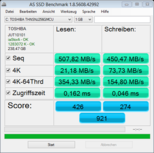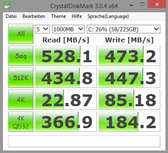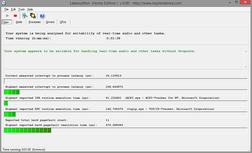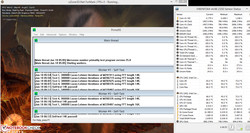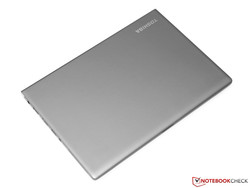Toshiba Satellite Z30-B Notebook Review

For the original German review, see here.
Toshiba's Satellite series targets private consumers who want a light and portable Subnotebook. Our 13-inch Satellite Z30-B-100 review sample is the entry-level configuration sold at an RRP of 1099 Euros (~$1216). A brief glance at the specs reveals the standard equipment for present day devices: Intel Core i5 processor, 8 GB of working memory, integrated graphics card and a solid-state drive. However, the screen's specs are surprising - only an HD screen based on TN technology is installed. Meanwhile, we expect Full HD even in smartphones, and UHD is currently the trend in laptops - can such a device still compete in today's market?
Toshiba is apparently aware of this problem and offers the alternative Z30-B-10C with a matte Full HD screen (1349 Euros/~$1495). Dell's XPS 13, now also available with a Full HD screen for 1199 Euros (~$1327), is one of the hottest rivals the same as Asus' ZenBook UX305FA (4K resolution) for 999 Euros (~$1105).
Case
We are familiar with the casing of the Satellite Z30 from previous tests since Toshiba also uses it for its more expensive Portégé Z30 business models. The steel-gray, metallic colored magnesium casing still makes a very elegant impression in terms of feel and looks. Both display hinges, a narrow bar below the touchpad and Toshiba's logo on the lid are silver colored, which set an appealing contrast in conjunction with the black keyboard and black display bezel. Regrettably, the edges above and below the screen are rather wide, but fortunately all surfaces are matte and fingerprints are thus not an issue. The display hinges are agreeably smooth running and it is possible to open the lid with one hand, but still tight enough to prevent excessive rocking.
The stability of the just 1.2 kg (~2.6 lb) heavy laptop is also impressive. Thanks to the rubber stoppers (four in the corners, one in the center), the base unit is very stable and can only be pressed marginally without disconcerting creaking noises. However, the lid itself is very thin and consequently considerably more flexible. It is quite easy to warp it, and pressure instantaneously produces wave formations on the screen.
According to Toshiba, the laptop fulfills the requirements of the strict HALT test (Highly Accelerated Life Test) that is performed by the Technical Control Board Rhineland and simulates three years of use. In addition, drops from a height of up to 76 cm (~30 in) and small amounts of liquids (max. 30 ml) should not cause any damage. However, we did not test these claims.
The battery is integrated into the casing and cannot be removed from the outside. It is possible to remove the laptop's underside, but it is slightly awkward. We will take a closer look at the procedure in the Maintenance section.
Connectivity
The casing's business intention is noticed in its interfaces; a VGA port is actually almost extinct in modern and slim mobile laptops. A docking station port is also hinted on the underside, but, unlike the Portégé series, there is only a plastic cover. Overall, we have to praise Toshiba for the good interface diversity. In addition to three full-sized USB 3.0 ports (1 with sleep & charge feature), a full-sized HDMI port, an Ethernet port, and an SD-card reader are installed - not bad for such a slim device. The card reader is on the casing's left far front making it easy to access. All other interfaces are further back on both sides, and thus do not interfere with using an external mouse. There is enough space between the individual ports on the left, but the right is rather more cramped. A wide USB flash drive could easily cover the neighboring port.
The interface performance did not show any irregularities. We could copy data at approximately 190 Mbps on Toshiba's Satellite Z30-B-100 using an external SSD (Samsung 830 64 GB) via USB 3.0.
Communication
Unlike most current Subnotebooks, the Satellite Z30 features a Gigabit Ethernet port and is not dependent on slower USB adapters. Naturally, wireless Internet is also possible. Intel's Dual Band Wireless-AC 3160 supports the latest standards including 802.11ac (2.4 and 5 GHz networks). However, the maximum transmission rate is limited to 433 Mbps (1x1). No unusual problems or interruptions were encountered in the test. In addition to Bluetooth 4.0, the module also supports Intel's Wireless Display, which enables wireless transmission of pictures in conjunction with suitable receivers.
The maximum transmission rate was 272 Mbps (802.11n; 62 Mbps) using an AC router (Asus RT-AC66U) at a distance of approximately 2 meters (~6.6 ft). Although there are now considerably faster modules, the performance is definitely enough for routine use.
A webcam with a 2.0 MP lens is located above the screen. It takes videos and photos with up to 1920x1080 pixels. The quality is sufficient for video chats, but a smartphone or camera should preferably be used for taking pictures. We found the stereo microphone more compelling since it records voices very loud and clear.
Accessories
In addition to the laptop itself, the box contains only the compact 45-watt power supply, a manual and warranty information.
Toshiba offers only optional universal accessories, such as power supplies and bags.
Maintenance
The entire underside of the Z30-B-100 can be removed, but unfortunately, Toshiba complicates the matter unnecessarily. In addition to the visible Philips screws, there are three more screws underneath the rubber stoppers. We did not open the casing to avoid damaging the review sample (shop device). However, detailed and illustrated dismounting instructions in English can be found here. The mSATA SSD, Wi-Fi adapter, working memory (1 slot empty) and the battery can then be replaced and the fan can be cleaned.
Warranty
Toshiba includes a two-year manufacturer's warranty on the Satellite Z30-B-100 in Europe when the product is registered. In Germany and Austria, the device is picked up directly from the owner once the defect is reported to Toshiba's repair hotline.
There are also optional warranty upgrades and extensions that can be purchased via the seller.
Input Devices
Keyboard
The matte-black keyboard made an overall good impression. Only some function keys (e.g. Page Up/Page Down) deviate from the standard layout and a long familiarization period is not needed. The keys' size of 15 x 15 millimeters (~0.6 x 0.6 in) is also good; only the function keys on the uppermost row are smaller.
We liked the typing feel, but the keyboard's center yielded slightly while typing, and was quite loud. However, the stroke was pleasantly firm and accurate, and will provide the user with good feedback.
The single-level backlight has a special feature. Not only can it be turned on and off, but also a third setting automatically disables the light when the keyboard is not used for approximately 10 seconds and turns it on again when a key is pressed. This saves energy, and could prove convenient, especially when playing videos (e.g. in the dark).
Touchpad
Questions may arise when using the touchpad for the first time because two wide, separated areas without apparent functionality are above and below the input device. A closer look at the Portégé Z30 business model unravels the mystery. There are additional keys for a Touch Stick on the keyboard and a fingerprint reader below the touchpad.
The touchpad is a ClickPad from Alps. The size is acceptable, especially when considering the screen's low resolution. However, it could be somewhat larger for using multi-touch gestures with up to four fingers more comfortably. The surface has been roughened slightly, but still has good gliding properties. Two narrow and somewhat protruding lines clearly mark the two integrated mouse keys, and the fingers can find them very easily. The quiet click noise and decent drop appealed to us.
In addition to the usual configuration options in the driver (key assignment, enabling/disabling gestures, etc.), there are two additional functions in the two upper corners, which can be enabled by double tapping. The entire ClickPad can be disabled in the upper left, which is especially useful when using an external mouse. Toshiba's Eco energy profile can be enabled in the upper right. Unfortunately, neither area can be reconfigured.
Display
After the enormous improvements in the smartphone market, there are now also increasingly more high-resolution screens in laptops. However, Toshiba has ignored this trend in the Z30-B-100 and installed a matte, HD screen (1366x768 pixels) that is based on TN technology in the device. Consequently, in our comparisons, the laptop drops significantly behind the other competitors because both Dell's XPS 13-9343 (1920x1080 pixels) and Asus' ZenBook UX305FA (3200x1800 pixels) have a clear advantage here. Toshiba has devices with a matte, Full HD screen (Z30-B-10C) or a matte, Full HD touchscreen (Z30-A) within its Z30 series that are both available for 1349 Euros (~$1493).
Regrettably, the screen is very disappointing subjectively. The brightness is still its best quality. With an average of 286 cd/m², the backlight in conjunction with the matte screen is strong enough, and the illumination is a very good 91 percent. Unfortunately, the maximum brightness is limited to 232 cd/m² in the battery mode, which is important for a mobile device.
The high black level of 0.69 cd/m² makes dark areas look very faded and grayish rather than black. Overall, the image is quite pale (contrast 422:1) and slightly grainy. Neither games, nor videos are much fun with that. Compared with Dell's XPS 13 and Asus' ZenBook UX305 rivals, our review sample is clearly at a disadvantage (see chart). We would have expected a better screen, especially in a device designed for private consumers.
| |||||||||||||||||||||||||
Brightness Distribution: 91 %
Center on Battery: 232 cd/m²
Contrast: 422:1 (Black: 0.69 cd/m²)
ΔE ColorChecker Calman: 9.34 | ∀{0.5-29.43 Ø4.77}
ΔE Greyscale Calman: 11.09 | ∀{0.09-98 Ø5}
65% sRGB (Argyll 1.6.3 3D)
42% AdobeRGB 1998 (Argyll 1.6.3 3D)
45.31% AdobeRGB 1998 (Argyll 3D)
65.3% sRGB (Argyll 3D)
43.79% Display P3 (Argyll 3D)
Gamma: 2.23
CCT: 12686 K
| Toshiba Satellite Z30-B-100 HD Graphics 5500, 5200U, Toshiba THNSNJ256GMCU | Asus ZenBook UX305FA-FB003H HD Graphics 5300, 5Y10, SanDisk SD7SN3Q256G1002 | Dell XPS 13-9343 Non-Touch HD Graphics 5500, 5200U, Samsung SSD PM851 M.2 2280 128GB | Apple MacBook Air 13 inch 2015-03 HD Graphics 6000, 5650U, Apple SSD SD0256F | |
|---|---|---|---|---|
| Display | 31% | 44% | -8% | |
| Display P3 Coverage (%) | 43.79 | 58.2 33% | 65.9 50% | 40.1 -8% |
| sRGB Coverage (%) | 65.3 | 83.3 28% | 89.6 37% | 59.8 -8% |
| AdobeRGB 1998 Coverage (%) | 45.31 | 60.1 33% | 66.2 46% | 41.51 -8% |
| Screen | 24% | 52% | 28% | |
| Brightness middle (cd/m²) | 291 | 310 7% | 409.7 41% | 329 13% |
| Brightness (cd/m²) | 286 | 309 8% | 405 42% | 310 8% |
| Brightness Distribution (%) | 91 | 90 -1% | 93 2% | 82 -10% |
| Black Level * (cd/m²) | 0.69 | 0.75 -9% | 0.366 47% | 0.405 41% |
| Contrast (:1) | 422 | 413 -2% | 1119 165% | 812 92% |
| Colorchecker dE 2000 * | 9.34 | 2.49 73% | 7.67 18% | 3.96 58% |
| Greyscale dE 2000 * | 11.09 | 1.89 83% | 4.66 58% | 3.51 68% |
| Gamma | 2.23 99% | 2.36 93% | 1.65 133% | 3.83 57% |
| CCT | 12686 51% | 6573 99% | 6502 100% | 6711 97% |
| Color Space (Percent of AdobeRGB 1998) (%) | 42 | 54 29% | 59.65 42% | 38.4 -9% |
| Color Space (Percent of sRGB) (%) | 65 | 83.1 28% | 59.8 -8% | |
| Colorchecker dE 2000 max. * | 7.51 | |||
| Total Average (Program / Settings) | 28% /
26% | 48% /
50% | 10% /
19% |
* ... smaller is better
The assessments using the CalMAN software confirm our subjective impression, and exhibit a very clear shift of all colors toward blue, as well as a much too cool color temperature with 12686 K. In state of delivery, the average shift of the colors compared with the sRGB reference color space is over 9 (target: <3), and there is a peak with a DeltaE of over 15 in green and skin colors. The average DeltaE shift of over 11 is even higher in the grayscale levels.
The screen only covers 65 percent of the sRGB color space and 42 percent of the AdobeRGB standard. However, professional users will probably avoid this screen anyway.
The matte screen allows pleasant outdoor work without struggling with annoying reflections. However, the backlight is not bright enough for comfortable use in direct sunlight. Although the screen's content can still be recognized, after a while, it becomes very strenuous for the eyes. There should not be any problems in the shade.
Regrettably, the viewing angles of the Satellite Z30-B-100 are throughout disappointing. The TN screen is very susceptible to shifts, and the opening angle often has to be adjusted particularly when used on the lap. In contrast to good TN screens, brightness and contrast losses are visible even with slight, horizontal deviations. The situation is more extreme vertically because the colors invert quickly, making it difficult for several people to look at the contents at the same time.
Performance
Toshiba's Satellite Z30-B-100 is a state-of-the-art Subnotebook. Thanks to the fast Intel Core i5, 8 GB of working memory (DDR3L-1600, single-channel) and the solid-state drive, it should not have any problems with most routine tasks, including office and uncomplicated multimedia applications. The Z30-B-10C sister model sold at an RRP of 1349 Euros (~$1493) has the same components except for the screen (matte, FHD). Although the working memory operates only in single-channel mode, this condition can be eliminated quite easily and inexpensively when required, thanks to the second, empty RAM bank.
Processor
Intel's Core i5-5200U is a dual-core processor based on the Broadwell architecture, and is built using the cutting-edge 14 nm process. Its TDP of 15 watts makes it very suitable for mobile devices like the Satellite Z30. The chip supports all common features, such as Hyperthreading (up to four threads simultaneously) and automatic overclocking via Turbo Boost (2.7 GHz for one core; 2.5 GHz for two cores). The base rate of 2.2 GHz can be reduced to 800 MHz in idle mode.
Unfortunately, the processor cannot completely utilize its Turbo Boost in the single-core benchmarks because the processor runs at 2.5 GHz, and only occasionally speeds up to 2.7 GHz for short periods. Neither the consumption nor the temperatures are critical in this scenario, and thus it looks as if the manufacturer has limited it. The XPS 13 with an identical processor is roughly 10 percent faster in this scenario, and Asus' ZenBook UX305 with its energy-efficient Core-M lags behind by 16 percent.
The situation improves as soon as we load both cores. The processor can then maintain its maximum Turbo Boost frequency of 2.5 GHz. Accordingly, the review sample and XPS 13 are virtually on par in the Cinebench R15 multi-core test, while the ZenBook UX305 falls behind by almost 40 percent. The Satellite Z30-B-100 does not have any issues with throttling during pure CPU load.
The processor can also utilize its full performance in battery mode. More information and benchmarks about the Core i5-5200U can be found in our Tech section.
System Performance
As could be guessed when looking at the components, the performance in the Satellite Z30-B-100 does not give cause for complaint. Thanks to the solid-state drive, the subjective speed is very good, and there are no delays when opening applications. The synthetic PCMark benchmarks also confirm this impression. Dell's XPS 13 is on a very similar level (+/- 5 percent), while the weaker Asus' ZenBook UX305FA lags behind slightly (-12/-34 percent). The somewhat stronger processor and the considerably faster PCIe SSD explains the lead of Apple's MacBook Air 13.
| PCMark 7 - Score (sort by value) | |
| Toshiba Satellite Z30-B-100 | |
| Asus ZenBook UX305FA-FB003H | |
| Dell XPS 13-9343 Non-Touch | |
| Apple MacBook Air 13 inch 2015-03 | |
| PCMark 8 - Home Score Accelerated v2 (sort by value) | |
| Toshiba Satellite Z30-B-100 | |
| Asus ZenBook UX305FA-FB003H | |
| Dell XPS 13-9343 Non-Touch | |
| Apple MacBook Air 13 inch 2015-03 | |
| PCMark 7 Score | 4531 points | |
| PCMark 8 Home Score Accelerated v2 | 3095 points | |
| PCMark 8 Work Score Accelerated v2 | 4169 points | |
Help | ||
Storage Device
Toshiba's own solid-state drive, THNSNJ256GMCU, is installed in the Satellite Z30-B-100. This mSATA drive has a capacity of 256 GB, and achieves decent transfer rates of up to 530 Mbps in read and up to 470 Mbps in write. This is the range where the SATA standard acts as the limiting factor. The results of processing small files (4K) are unremarkable. Our review sample cannot compete with the extreme performance of cutting edge PCIe SSDs. However, the subjective differences when using a fast SSD are very marginal, if at all noticeable.
More tests and comparisons can be found in our HDD/SSD comparison.
Graphics Card
The integrated Intel HD Graphics 5500 graphics card has a core rate of 900 MHz (24 EUs) and supports DirectX 11.2. The GPU's power is sufficient for multimedia applications, and video editing highly benefits from the very efficient Quick Sync technology.
Unfortunately, the working memory connected in single-channel limits the GPU's performance in the Satellite Z30-B-100. A second RAM module could increase the performance by up to 20 percent; Dell's XPS 13-9343 has an edge of 15 percent in 3DMark 11 (983 vs. 1133 points). Asus' ZenBook UX305FA, with the weaker Intel HD Graphics 5300, falls behind by 30 percent. The graphics performance is also fully available in battery mode.
More information and benchmarks can be found in our Tech section.
| 3DMark 11 - 1280x720 Performance (sort by value) | |
| Toshiba Satellite Z30-B-100 | |
| Asus ZenBook UX305FA-FB003H | |
| Dell XPS 13-9343 Non-Touch | |
| Apple MacBook Air 13 inch 2015-03 | |
| 3DMark 11 Performance | 982 points | |
| 3DMark Ice Storm Standard Score | 40360 points | |
| 3DMark Cloud Gate Standard Score | 4499 points | |
| 3DMark Fire Strike Score | 592 points | |
Help | ||
Gaming Performance
Current games can be played at most, using low details and low resolutions. Even so, smooth frame rates are not always possible (“Bio Shock: Infinite” only 28.07 fps). Some older and less demanding games (“Fifa”, “Diablo 3”, “DOTA 2”, etc.) can be played well anyway, and the same is true for games from the Windows Store. An additional RAM module would improve the performance by approximately 15-20 percent, but still would not make the Satellite Z30-B-100 into a gaming laptop.
An overview of the requirements of up-to-date games can be found in our benchmark chart.
| low | med. | high | ultra | |
|---|---|---|---|---|
| Tomb Raider (2013) | 43.3 | 22.2 | 14.1 | |
| BioShock Infinite (2013) | 28.07 | 16.93 | 13.85 | |
| GRID: Autosport (2014) | 64.6 | 24.05 |
Emissions
System Noise
Toshiba's Satellite Z30-B-100 is a very quiet companion. The fan normally remains inactive during low load, and the user should be pleased with a silent device without annoying noises. Under full load, the small fan can get very loud with up to 44.1 dB(A), but that is rather the exception. The laptop is not subjectively distracting in this state since the fan does not roar unpleasantly or produce high-pitched tones.
Noise level
| Idle |
| 29.6 / 29.6 / 31.9 dB(A) |
| Load |
| 41.2 / 44.1 dB(A) |
 | ||
30 dB silent 40 dB(A) audible 50 dB(A) loud |
||
min: | ||
Temperature
The surface temperatures are absolutely uncritical - both in idle as well as under load. Although there is a hot spot on the upper side over the keyboard's center, this point will rarely be touched during use and the temperature is not annoying. In normal use such as Internet browsing, a temperature increase is hardly noticeable. It is possible to use the device on the lap provided there is sufficient airflow. The air inlet is located on the underside, which could be easily covered. The lack of air circulation can cause the temperatures to climb rapidly, especially during demanding tasks.
(±) The maximum temperature on the upper side is 40.6 °C / 105 F, compared to the average of 35.9 °C / 97 F, ranging from 21.4 to 59 °C for the class Subnotebook.
(+) The bottom heats up to a maximum of 34 °C / 93 F, compared to the average of 39.3 °C / 103 F
(+) In idle usage, the average temperature for the upper side is 24.6 °C / 76 F, compared to the device average of 30.8 °C / 87 F.
(+) The palmrests and touchpad are cooler than skin temperature with a maximum of 25.7 °C / 78.3 F and are therefore cool to the touch.
(+) The average temperature of the palmrest area of similar devices was 28.2 °C / 82.8 F (+2.5 °C / 4.5 F).
Stress Test
First, we checked the laptop's behavior when only the processor is put under stress. Both cores were fully loaded via the tool Prime95. The laptop remained quite stable in this scenario as both cores clocked at their maximum Turbo Boost rate of 2.5 GHz from the outset. This rate was not exceeded, and the maximum temperature remained at an uncritical 67 °C (~153 °F/battery mode identical).
Next, we checked the graphics card with the FurMark tool. Once again, the laptop did not really have problems. The graphics core could maintain its maximum core clock of 900 MHz, and its temperature was just 56 °C (~133 °F/battery mode identical).
We managed to stress the laptop slightly when we loaded both the processor and graphics card. The processor's consumption climbed over 20 watts in the first 15 seconds while both components clocked at their maximum rate (CPU: 2.5 GHz; GPU: 900 MHz), and the temperature reached 73 °C (~163 °F). The TDP limitation of 15 watts took effect after that, and the processor was throttled to 1.5 - 1.6 GHz. The system prioritizes the graphics card, and it continued to clock at 900 MHz. This behavior remained stable during the course of the test, and the temperature settled at approximately 69 °C (~156 °F).
In battery mode, the behavior was different and the TDP limitation immediately set in. The processor clocked stably at its base rate of 2.2 GHz while the graphics card ranged from 700 - 800 MHz. A 3DMark test performed right after the stress test did not show any constraints, which was not expected in view of the low temperatures.
Speakers
Both stereo speakers are found on the beveled underside at the front. The sound is thus directed onto the surface at an angle of 45°, and reflected towards the user in an ideal case (solid surface). Unfortunately, however, the positioning also has its drawbacks. Both small openings might be easily covered on soft surfaces. Even when typing the forearms could interfere with the quality. However, that is not overwhelming to begin with. The sound is very treble heavy, and there is no bass whatsoever. The maximum volume is also rather mediocre.
The preloaded DTS Studio Sound software provides multiple options to improve the result. A clear difference is audible when the software is enabled, and the sound becomes richer. However, music is not really enjoyable even in this state. The quality will certainly be enough for a short YouTube video, but headphones or external speakers should be used for a better sound (Bluetooth, HDMI, 3.5 mm jack).
Tethering an external Bluetooth speaker (Denon Envaya Mini) functioned without any problems, and the quality was beyond reproach. There were no lags or interruptions during playback. The result was also considerably better with headphones (Sennheiser Urbanite), but the DTS software should definitely be disabled in that case.
Energy Management
Power Consumption
The idle consumption rates are very low, even for a slim 13.3-inch Subnotebook. The screen's low pixel count is also noticed here because the backlight does not need as much energy as high-resolution screens. The 45-watt power supply's capacity is high enough to deal with the maximum measured power consumption of 28.8 watts, and even has enough reserves to recharge the laptop quickly during use.
| Off / Standby | |
| Idle | |
| Load |
|
Key:
min: | |
Battery Runtime
The low consumption rates alongside the 52-Wh battery promise very good runtimes, which our tests confirmed. According to Toshiba, the Satellite Z30-B-100 will run up to 16 hours. That was clearly exceeded with 23:33 hours in Battery Eater's Reader's test. Almost 3 hours was possible in the worst-case scenario (Battery Eater's Classic test). However, neither scenario is very realistic for a mobile Subnotebook, and thus we will take a closer look at our real-life Wi-Fi test.
The laptop runs a browser script that simulates Internet browsing at a screen brightness of approximately 150 cd/m² (level 6/10). The determined runtime of 12:02 hours is very impressive, and clearly outruns the competition, including the long-lasting Apple's MacBook Air 13. Consequently, a whole workday on battery power should not be a problem.
A full recharge (rest capacity: 3 percent) took approximately 2:30 hours when the laptop was on.
Toshiba states a shorter runtime of approximately 10 percent for the Full HD sister model, but the Wi-Fi runtime would then still be very competitive.
| Toshiba Satellite Z30-B-100 HD Graphics 5500, 5200U, Toshiba THNSNJ256GMCU | Asus ZenBook UX305FA-FB003H HD Graphics 5300, 5Y10, SanDisk SD7SN3Q256G1002 | Dell XPS 13-9343 Non-Touch HD Graphics 5500, 5200U, Samsung SSD PM851 M.2 2280 128GB | Apple MacBook Air 13 inch 2015-03 HD Graphics 6000, 5650U, Apple SSD SD0256F | |
|---|---|---|---|---|
| Battery runtime | -19% | -15% | -17% | |
| Reader / Idle (h) | 23.6 | 13 -45% | 21.6 -8% | 26.2 11% |
| WiFi v1.3 (h) | 12 | 10 -17% | 10.3 -14% | |
| Load (h) | 3 | 3.2 7% | 2.4 -20% | 1.6 -47% |
| WiFi (h) | 6.8 |
Pros
Cons
Verdict
Toshiba does a good job in many aspects of the Satellite Z30-B-100. Although the casing is slightly old, we still like it and the low weight and compact size completely fulfill its mobility claim. In addition, it features up-to-date hardware, decent input devices, and an excellent battery life. So is it the perfect companion for private consumers?
We think not because the review sample failed to impress us in one of the most important points: The HD TN screen is (almost) throughout disappointing. Its only positive quality is the matte surface. We would have actually hoped that the era of inferior screens in laptops is over, at least in the ones that cost over 1000 Euros (~$1106).
Buyers who opt for Toshiba's Satellite Z30 should definitely select a configuration with a Full HD screen.
The rivals in form of Dell's XPS 13-9343 and Asus' ZenBook UX305FA thus have a decisive advantage, which ultimately leads to a better overall package. The current street price of our review sample is just under 1000 Euros (~$1106), and although the good performance in the other sections results in a good total rating of 85 percent, we cannot recommend the present test configuration due to its poor screen.
Toshiba Satellite Z30-B-100
- 06/18/2015 v4 (old)
Andreas Osthoff


